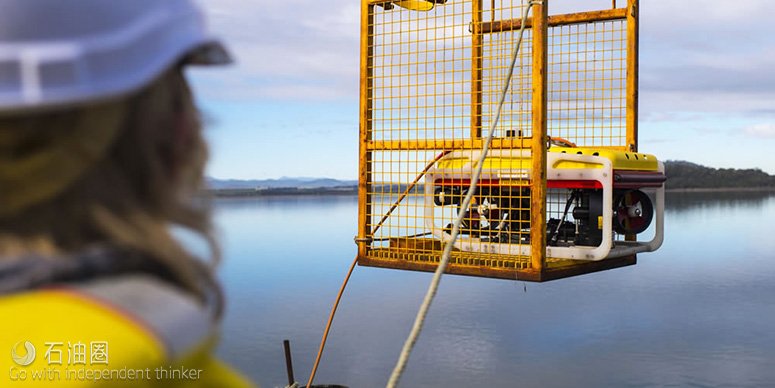Given the value of real estate on offshore platforms and vessels, advocates for electrically powered remotely operated vehicles (ROVs) start with a strong argument: electric ROVs have a smaller physical footprint than their traditional hydraulically operated counterparts do. They also require less operational crew. Yet in most tasks they can go head to head with traditional ROVs.
“They’re pretty much on the same level playing field as far as the same capabilities and performance,” says Chris Roper, sales manager for Saab Seaeye North America. “The same types of tasks are now being performed using electric work-class ROV systems [as by hydraulic ROVs]. In some cases, electric ROVs can exceed the capabilities of the larger hydraulic ROVs.”
For example, the smaller cross section of electric ROVs means they can work in higher currents, Roper says. Seaeye’s newest addition to its electric ROV line up, the Leopard, can operate in 4 knots of current head-on.
Seaeye, which celebrated its 30th year in the electric propulsion business in 2016, “perfected underwater electric thrusters, and the ROV technology was built around the thrusters,” says Roper, a former commercial saturation diver.
Some operators have stated a preference for using electric ROVs for environmental reasons, partly because electric ROVs don’t carry oil on board.
Further, the industry is moving toward all-electric components in the subsea environment, such as all-electric actuators.
“To have electric ROVs interfacing with electric hardware makes a lot of sense,” Roper says. “Electrics on the seafloor is better from an environmental standpoint, and the payoff is better at the end of the day” in terms of overall efficiency and lower lifetime costs.
Additionally, electric operations are extremely quiet, he says. “We’re not making electric noise that will interfere with sensor systems.”
Seaeye is promoting two of its latest electric underwater units: Leopard work class ROV and the Sabertooth inspection and light maintenance hybrid vehicle. The company refers to its Sabertooth unit as an “intelligent hybrid” that merges autonomous underwater vehicle (AUV) and ROV technology into a single vehicle that can, through wireless communication, roam, hover and perform tether-less light intervention tasks.
The Sabertooth has 30 KW hours of onboard battery power, which gives it about 18 hours of operations at 3-4 knots of underwater travel speed.
“It’s a tremendous amount of power,” Roper says.
The Sabertooth can reside on the seabed at depths of up to 3000 meters for as long as a year at a time while connected to a host platform or subsea power outlet.
“The driver on all this is to carry out IMR (inspection, maintenance and repair) tasks from a shore-based location, or offshore with a reduced crew, and reduce the frequency the ROV needs to be dropped into and retrieved from the water,” he says. “This reduces the need for vessels.”
The unit, which uses free space optic technology for communications, can inductively charge at a subsea power station. The rechargeable lithium battery takes 6-8 hours to recharge.
Roper believes the unit’s presence on the seafloor will provide the user with more data.
“A lot of what we’re working on is the ability to detect environmental changes,” he says.
While the Sabertooth has been deployed for routine operations around the world, it has not yet been deployed as a seabed resident, Roper says. Such an application will likely be “some time out” as Seaeye still must carry out long-term immersion testing. The testing will take place at Lake Vattern near Saab’s Motala facility in Sweden.
“We have proven out 95% of all the required components to put it onto the seafloor. It’s just the final assembly of all the components for a long-term immersion test, which is going to start in 2017,” he says.
Seaeye recently demonstrated the Sabertooth’s functionality in a trial at the NASA Neutral Buoyancy Lab at the Johnson Space Center, in Houston.
As for the Leopard ROV, Roper calls it the “most powerful vehicle that Seaeye has ever built”. The Leopard and Sabertooth vehicles share “a lot of crossover”, he notes. For instance, both use the same electric thrusters and the same iCON (intelligent control) systems. The Leopard, fitted with eight horizontal and three vertical thrusters, receives power down the tether. The eight horizontal thrusters produce over half a ton of bollard pull, which propels the vehicle forward at a speed of 4.2 knots.
Most of the Leopards in operation are working in Australia, the Middle East and Far East deepwater. UK-based ROVOP is about to take delivery of the first Leopard for use in the Gulf of Mexico, while a unit for use off the eastern coast of Canada is set for delivery in early 2017.
The Leopard is rated to 3000 metres water depth. In some operations, the ROV has remained submerged for more than 20 days. It can stay on task even in strong currents, according to the company.
“The mechanics are strong. Very little goes wrong. We have very few operational downtimes. We don’t blow a hose,” Roper says. The unit can keep working in the event of multiple equipment damage, he adds— auto redundancy is performed by iCON, which independently manages each intelligent device on the vehicle.
Roper sees twin goals in the near future for electric ROVs. One is to make them fully resident on the seabed, and the other is to replace existing hydraulic tools with electric tooling and manipulator technology.
“There’s a real move in Saab Seaeye to develop electric tools and electric manipulators. It doesn’t make a lot of sense to put hydraulic tools on an electric vehicle.”
Seaeye expects to introduce some electric tooling this year followed by electrically controlled manipulators in 2018.


 石油圈
石油圈

